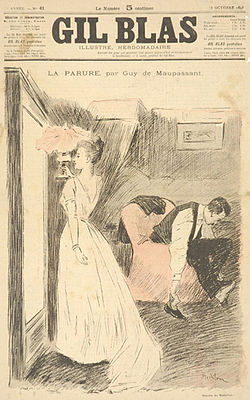Plot
Mme Mathilde Loisel is a beautiful but discontented woman born into a modest family who dreams of wealth, glamour and social prestige, a life she believes she was meant for but cannot afford on the salary of her husband, a clerk at the Ministry of Education.
One day, her husband surprises her by bringing home an invitation to a grand ball hosted by the minister. While he is excited about the chance to attend such a prestigious event, she frets that she has nothing suitable to wear. Her husband sacrifices his savings of 400 francs, intended for a hunting rifle, to buy her a beautiful new dress. Mathilde remains dissatisfied, however, as she has no jewels to wear with it. She rejects her husband's idea of wearing fresh flowers, but takes up his suggestion of borrowing jewellery from her wealthy friend, Mme Forestier. Mme Forestier is happy to help, and offers Mathilde many fine pieces to choose from. She selects a diamond necklace.
At the ball, Mathilde enjoys dancing with influential men, and revels in the attention. However, upon returning home, Mathilde discovers that the necklace is missing. Panicked, she and her husband search extensively but unsuccessfully. Afraid to admit the loss to Mme Forestier, the Loisels decide they will have to replace the necklace. They visit numerous jewellers until they find an almost identical model, for which they have to pay 36,000 francs. Mr Loisel uses an inheritance from his father to cover half the cost and borrows the rest at high interest. Mathilde gives the necklace to Mme Forestier, who does not notice the substitution.
To repay the debt, the Loisels dismiss their maid, move into a small, shabby apartment, and take on long hours of gruelling work. It takes ten years for the Loisels to repay their debts and accumulated interest, by which time Mathilde has lost her youthful beauty and become prematurely aged from her years of poverty and toil.
Debt-free at last, Mathilde encounters Mme Forestier by chance in the street. Having not seen her former friend for ten years, Mme Forestier barely recognises her. Feeling confident enough now to confess, Mathilde tells Mme Forestier the truth about losing the necklace, replacing it, and about the hard times she has endured. A horrified Mme Forestier reveals that the necklace she had lent to Mathilde was not made of real diamonds, and was worth no more than five hundred francs.
This page is based on this
Wikipedia article Text is available under the
CC BY-SA 4.0 license; additional terms may apply.
Images, videos and audio are available under their respective licenses.
